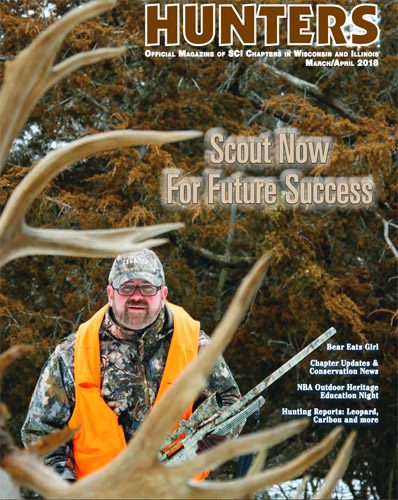
The adventure started with a face-to-face outfitter visit at the SCI Wisconsin Chapter Grand Banquet.
Hunting caribou with Moose Hunting North on the border of Manitoba and Nunavut this fall was an adventure and a marvelous experience.
After achieving a Fall 2015 hunting goal, I was trying to decide what and where my next hunt might be. At the 2016 SCI Wisconsin Chapter Grand Banquet in Lake Geneva, Wisconsin, my husband, Mike, and I met with a representative from Moose Hunting North. Based on the literature, photos, and his descriptions of the herd, a caribou hunt seemed to fit the bill. The Central Barren Ground Caribou presented an opportunity for success with a species I had not yet hunted. It was also a chance to visit a new locale. We booked our 2-on-I caribou hunt for Fall 2017. Between booking the hunt and the actual time of the hunt we were in touch with us several more times. Every contact was pleasant and helpful.
We arrived in Thompson, Manitoba a day-and-a-half prior to our scheduled flight to Ganglers North Seal River Lodge. This gave time to explore Thompson, arrange our gear to meet weight restrictions, and arrange secure parking for our vehicle. On Saturday, September 23 we flew out of the Thompson airport on a very large charter airliner with Calm Air. We landed on the runway at the Lodge, had a meet and greet, and then transferred to a floatplane for the trip to No-name Lake camp. The lake is located on the border of Manitoba and Nunavut. It is about 2-1/2 hours total flying time from Thompson. We were hunting the third and final week of the season during the migration of the Quamairjuaq Central Barren Ground herd. The previous two years the herd had been delayed in their migration and hunters in the first two weeks hardly saw a caribou. However, this year the migration started early and, as we discovered during the course of the week, was almost over at our location when we arrived. We each had the opportunity of two caribou licenses, ptarmigan hunting, catch-and-release fishing, and wolf hunting (one each). The harvest we ended up with was three caribou, no ptarmigan, no fish, and no wolves sighted.
After a brief orientation and meeting our assigned guide, John Denechezhe, we sighted in our rifles and headed out for our first hunt on the afternoon we arrived. John is a member of a native tribe that hunts in the area. He is knowledgeable, experienced, and has guided with Moose Hunting North for a number of years. He is soft-spoken, does not fluster, and thoroughly knows the area and trails that caribou use.
John took us by boat (about an hour ride) to the location that he thought had the best opportunity of sighting caribou. Once at our location we climbed a hill and began to glass. Within 15 minutes we saw three caribou in the distance cresting a hill.
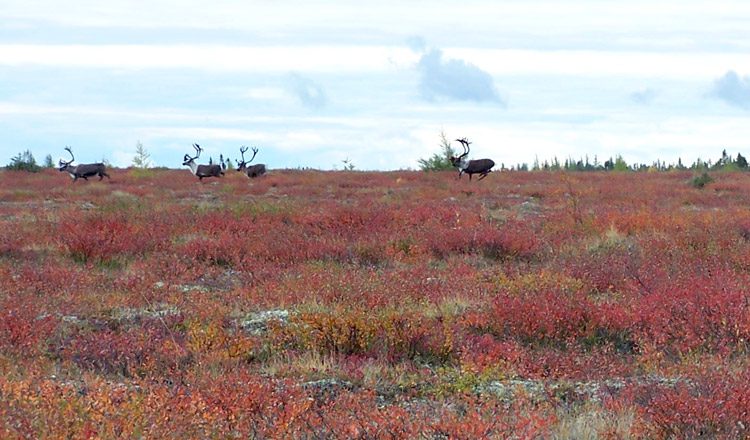
John knew which way they would go and had us move off the hill to a location closer to where they would cross our path. Of the three bulls, I scoped the largest, which John said was an average bull about seven years old. Mike chose to wait for a larger bull. My rifle of choice is a ported Remington 7mm STW. I use a 140-grain cartridge. I set up my shooting sticks and watched the caribou come closer through the scope. At about 170 yards, I thought John said shoot, so I did. The caribou went down but struggled to get back up. I racked in another shell and put a finishing shot in the bull.
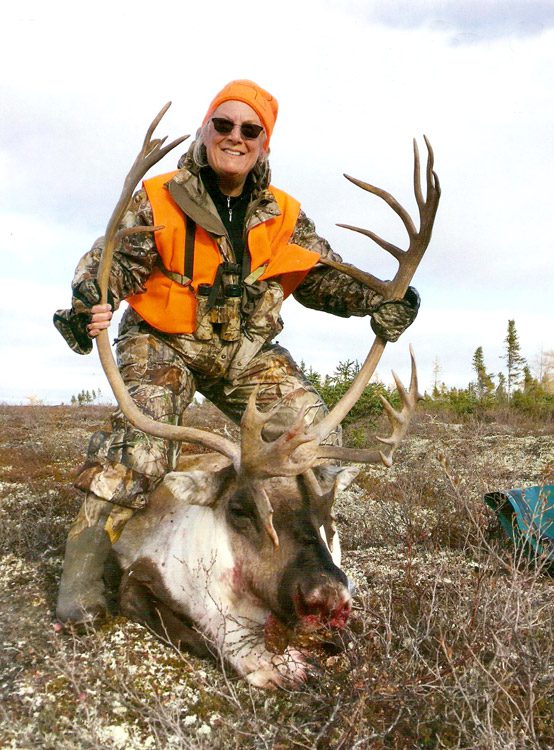
As it turned out I misheard soft-spoken John. He actually said, “Don’t shoot,” because he thought the caribou would come closer. Closer was better because it meant less distance to pack meat, horns, and hide to the boat. However, John was very efficient at field dressing and within an hour we were packing guns, packs, meat, horns and just enough hide for a shoulder mount to our boat. We left the gut pile, lower legs, bones, scraps and some hide. This is important to note because a few days later we watched as a wolverine emerged from the brush at the edge of the lake and ran up to the gut pile. The wolverine rolled in the gut pile, thoroughly putting its scent on the remains while ignoring the scolding of the resident raven. Then it took the remaining hide in its teeth and hauled it back down the hill to its lair. This was our reminder to never forget the place of hunting in the circle of life. When humans harvest an animal other animals benefit.
After the excitement of taking a caribou on the first day, the next four days were disappointing for sighting any caribou. One day a small bull and a calf ran within 50 yards of us as if they were being chased. We waited for a pack of wolves to come behind them, but no such luck. Another day we watched the wolverine roll in the gut pile. Snow geese were abundant for watching and the foliage on mosses, lichen and tamarack were brilliant, but the caribou seemed to be gone.
None of the other hunters and guides were seeing caribou either.
The outpost camp manager was in touch with the main camp each day. He kept them apprised of lack of harvest and few sightings, as well as weather. On Tuesday the small floatplane came in with more hunters for our camp. If hunting slows down, Moose Hunting North asks their pilots to do a recon flight, watching for herds of migrating caribou. We had learned the previous day that there was a large group to the north (in Nunavut) poised to move at the first snow. There were also smaller groups to the east and south.
When the floatplane left it took two of our hunters and their guide to another lake closer to the Caribou River where they also migrate down. Each hunter harvested a bull and they ended up spending a night on the tundra when they could not make it back to the pickup location in time for the floatplane.
Based on their success Moose Hunting North decided to fly more hunters from our camp to other locations. A lottery was set up and hunter’s names were drawn to determine who would fly out to hunt. I was not eligible for the draw since l had harvested a caribou. However, l had purchased second caribou tag the day after l bagged my first bull. Mike was eligible for the lottery but was not drawn.
As Thursday dawned it was apparent that no one was going anywhere on a plane due to fog. So, hunters and guides, drawn or not, were deciding what to do instead. Our guide, John, suggested that we hang around camp and let the fog lift a bit. Then we would head to a more distant location that we had hunted Sunday. When the fog lifted just a bit and the float- plane came in there was no one who had been drawn to go to the other lake left in camp. By sheer luck of not going out in the fog that morning, we ended up in the position to fly to another location where caribou were abundant.
We took off and quickly flew out of the remaining fog and clouds as we headed southeast for about 30 minutes. We saw groups of caribou as we flew and a tundra bear. We landed on a lake to the east. There was a group of celebrity hunters with Moose Hunting North filming a TV show somewhere nearby, although we did not see or hear them. The pilot said he would be back at 4pm for us and took off. We headed off and had only gone a short distance when we saw a small group of caribou ahead. We hoofed it to intersect them for a shot.
Mike selected a nice bull and when it seemed they might be getting spooky, he took a freehand shot at 280 yards. The bull went down, and the others continued on their journey. We took photos, and then John started to work on field dressing.
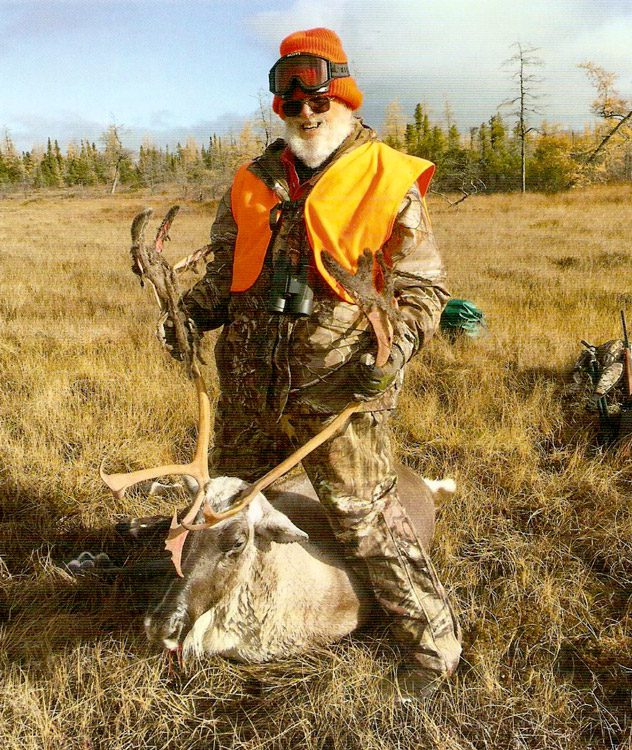
I was instructed to move about 300 yards to a good vantage point and watch for more caribou. If I saw a big bull I was supposed to harvest it. I then moved another 200 yards farther to a pinch point to continue looking for “the really big one.” No sooner had I set up my shooting sticks and started glassing when the shiniest, fanciest, red helicopter I had ever seen landed between John and Mike. It was Manitoba Fish and Game officers making routine field checks. They checked our credentials, firearms, and tags, which took about 45 minutes. We were all in compliance so off they went to enforce laws elsewhere in the province.
Mike started packing his caribou to the beach. His hands and back were loaded down so he decided to leave his gun near his kill sight. I decided to check my Kindle while watching for the next wave of caribou.
Soon, I heard John yell, “BULL!” I looked up in the direction I was facing and did not see anything. I then looked behind me at John and there were caribou all over the area between him, Mike, and the beach.
The herd seemed confused as Mike waved his arms and hollered at them in an attempt to get them to move away so he could get to his gun. The caribou milled around a bit and some started heading toward me. I scoped them all as they moved in my direction looking for the giant bulls that you see in the record books, Several were very nice and certainly larger than my first bull. I had my gun up and was ready when the one I selected was abreast of me and a clear shot. But, the bull continued coming toward me. When he was about 70 yards away and broadside I squeezed the trigger and down he went. What excitement and what a beautiful caribou!
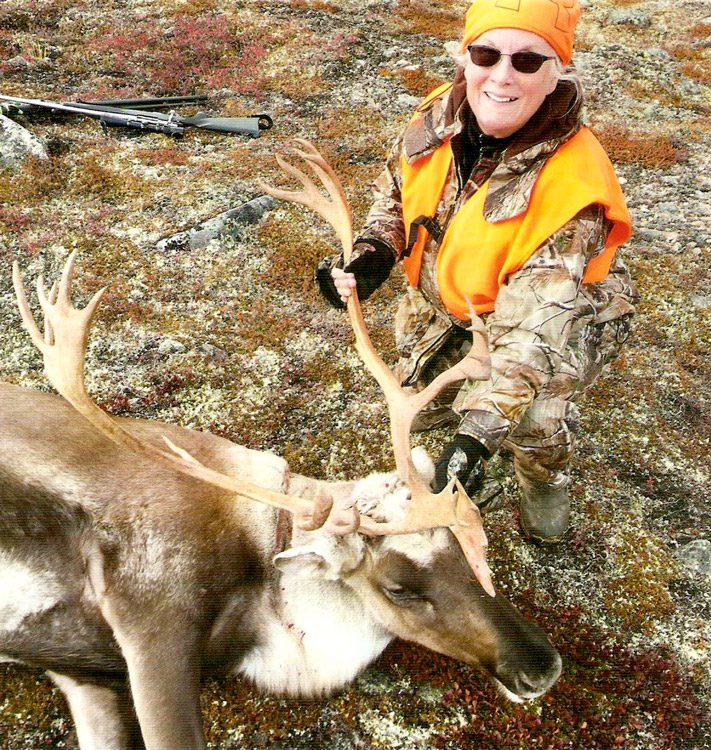
While I was focused on the bull coming toward me, Mike had his own issues with the caribou. Mike says that the rest of the herd moved toward his gun and surrounded it, so he had to keep moving toward them to reach it. By the time he got to the gun the herd was spooked and had moved out of range. Of course, time was running out to get even my bull cleaned before the plane came back for us, so it was probably a good thing he did not shoot a second bull.
When the pilot flew in we were just finishing the processing of my bull, The pilot tied up the plane and both of them hiked out to help us pack my bull out in one trip. We were on a tight schedule. The pilot needed to get us back to camp and then return before dark to pick up the film crew.
Back at camp we took some good-natured razzing. The drawn hunters were also razzed for not being in camp when the plane came and so on. The plan for Friday was, weather permitting, more hunters would fly to other locations with plentiful caribou and we (all the successful hunters to date) would fly to the main lodge. As it turned out the weather was bad, and no one flew anywhere until everyone departed camp late on Saturday for the main lodge and the flight back to Thompson.
If you ever have the opportunity to do a caribou (or other hunt) with Moose Hunting North, jump on it. This is one of the best run hunting businesses we have experienced. In addition, they went beyond their duty to make sure we had opportunities to find our target animal. I would not hesitate to hunt with Moose Hunting North (www.moosehuntingnorth.com) in the future.